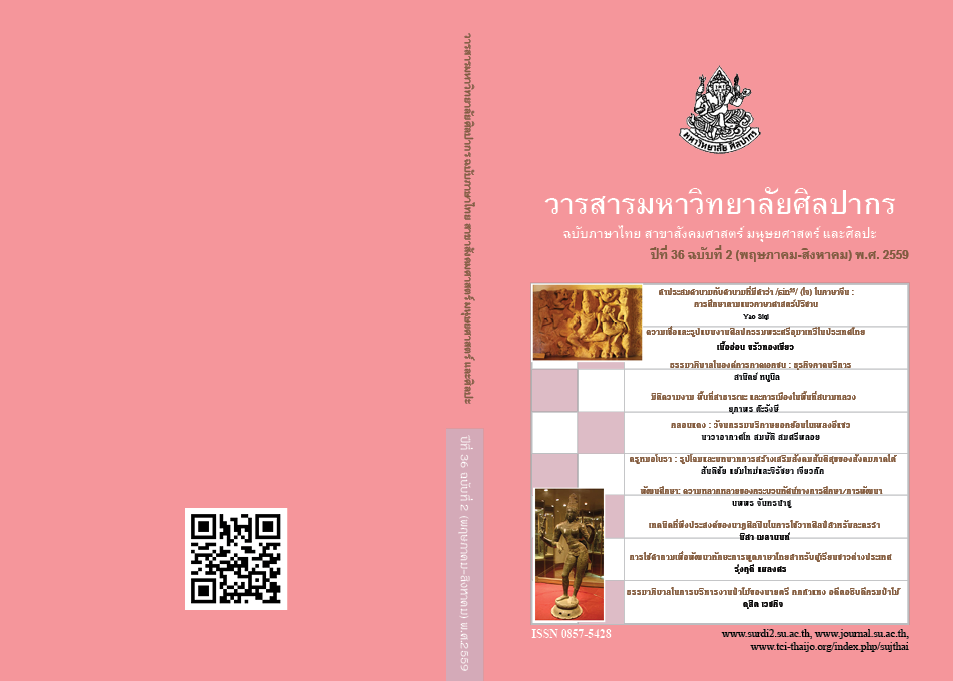คำประสมคำนามกับคำนามที่มีคำว่า /ɕin55/ (ใจ) ในภาษาจีน : การศึกษาตามแนวภาษาศาสตร์ปริชาน (A Study of /ɕin55/ (Heart) Noun-Noun Compounds in Mandarin Chinese: A Cognitive Linguistics Approach)
Main Article Content
Abstract
งานวิจัยนี้มีวัตถุประสงค์เพื่อศึกษาคำประสมคำนามกับคำนามที่มีคำว่า 心/ɕin55/(ใจ) ในภาษาจีนมาตรฐาน ผู้วิจัยศึกษาและวิเคราะห์ข้อมูลตามแนวคิดทฤษฎีภาษาศาสตร์ปริชานและงานวิจัยของรี่กา เบนซ์ (Réka Benczes, 2006) เป็นกรอบแนวคิดและได้เก็บรวบรวมข้อมูลจากพจนานุกรมภาษาจีนร่วมสมัย (The Contemporary of Chinese Dictionary) ฉบับภาษาจีน และฐานขอมูลของศูนยวิจัยภาษาศาสตรภาษาจีนที่มหาวิทยาลัยปกกิ่ง (Center for Chinese Linguistics Peking University) จำนวนทั้งสิ้น 77 คำ ผู้วิจัยได้จำแนกประเภทของคำประสมที่พบได้เป็น 3 ประเภท ได้แก่ (1) 心/ɕin55/เป็นส่วนแสดงความเด่น (2) 心/ɕin55/ เป็นส่วนขยาย (3) กรณีที่คำประสมคำนามกับคำนามเป็นหน่วยสร้างไร้ศูนย์ ในการวิเคราะห์ข้อมูล คำประสมแบบคำนามกับคำนามของภาษาจีนอาศัยกลไก 3 รูปแบบ ได้แก่ อุปลักษณ์เชิงมโนทัศน์ นามนัยเชิงมโนทัศน์ และการรวมอุปลักษณ์และนามนัย ผลการศึกษาพบว่า (1) เมื่อคำว่า 心/ɕin55/ ทำหน้าที่เป็นส่วนแสดงความเด่นของคำประสมคำนามกับคำนามในภาษาจีน คำว่า 心/ɕin55/ เป็นอุปลักษณ์ที่มีความหมายในเชิงเปรียบเทียบที่หลากหลาย ได้แก่ 1) ใจเป็นส่วนกลาง 2) ใจเป็นส่วนสำคัญที่สุด 3) ใจเป็นสภาพจิตใจ 4) ใจเป็นสภาพอารมณ์ และ 5) ใจเป็นความคิด ในขณะที่คำว่า 心/ɕin55/เป็นส่วนขยายพบว่ามีรูปแบบการแสดงการเชื่อมโยงทางความหมายเชิงเปรียบเทียบ 4 รูปแบบ ได้แก่ 1) ใจเป็นสิ่งที่มีอยู่จริง หรือสิ่งรูปธรรม 2) ใจเป็นสภาพจิตใจ 3) ใจเป็นสภาพอารมณ์ ความรู้สึก และ 4) ใจเป็นความคิด ส่วนคำประสมคำนามกับคำนามที่มีคำว่า 心/ɕin55/ เป็นหน่วยสร้างไร้ศูนย์ พบว่า คำว่า 心/ɕin55/มีความหมายในเชิงเปรียบเทียบ 2 รูปแบบ ได้แก่ 1) ใจเป็นสภาพจิตใจ และ 2) ใจเป็นความคิด นอกจากนี้ ผลการศึกษาครั้งนี้ยังมีประโยชน์ในการช่วยอธิบายปรากฏการณ์การประสมคำในภาษาจีน โดยอาศัยกลไกอุปลักษณ์เชิงมโนทัศน์ และนามนัยเชิงมโนทัศน์ ซึ่งเป็นเครื่องมือที่สามารถสะท้อนให้เห็นกระบวนการคิดของผู้ใช้ภาษาจีนด้วยเช่นกัน
Downloads
Article Details
References
Bloomfield,L. (1933). Language. Chicago IL: The University of Chicago Press.
Center for Chinese Linguistics PKU. 语料库检索系统(网络版). 2009
Chen, Y. (1982). A Study of Chinese and Thai Idiomatic Expresstions : A Comparative Study (สำนวนจีนและสำนวนไทย: กํารศึกษําเปรียบเทียบ). Master of Arts, Department of Thai, Faculty of Arts, Chulalongkorn University.
Charoensin, A. (1992). Travel to China (ท่องเมืองจีน). Bangkok: Rungsaeng.
Coulson,S. (2000). Semantic Leaps: Frame-shifting and Conceptual Blending in Meaning Con-struction. Cambridge: Cambridge University Press.
Fauconnier, G. (1997). Mappings in Thought and Language. Cambridge:Cambridge University Press.
Fauconnier, G. and Turner, M. (1998). Conceptual Integration Networks. Cognitive Science 22(1): 133-187.
Fauconnier, G. and Turner, M. (2002). The Way We Think: Conceptual Blending And the Mind’s Hidden Complexities. New York, NY: BasicBooks.
Huang, J. (2009). A Cognitive Approach to Chinese Metaphorical and Metonymical Noun - Noun Compounds Based on Reference Point Theory.Doctoral Dissertation (English Language and Literature). Shanghai : ShanghaiInternational Studies University.
Lakoff, G. and Johnson, M. (1980). Metaphor We Live by. USA.Chicago: The University of Chicago Press.
Langacker, R. W. (1987). Foundations of Cognitive Gammar, Vol.I Theoretical Prerequisites [M]. Stanford: Stanford University Press.
Langacker, R. W. (1991). Foundations of Cognitive Gammar, Vol.II Descriptive Applications [M]. Stanford: Stanford University Press.
Langacker, R. W. (2000). Grammar and Conceptualization [M]. Berlin and New York: Mouton de Gruyter.
Langacker, R. W. (2004). Metonymy in Grammar. Journal of Foreign Languages 6: 2-24.
Sweetser, E. (1999). Compositionality and blending. In Cognitive Linguistics: Foundations, scope,
and methodology [Cognitive Linguistics Research 15],Theo Janssen and Gisela Redeker (eds.),
129–162. Berlin: Moutonde Gruyter.
Shi, Y. (2011).The Role of Conceptual Metonymy and ICM in the Creation of Noun-Noun Com-pounds. Journal of Zhejiang Ocean University (Humanities Science), 28(2): 81-85.
Shi, Y. (2009). The Role of Conceptual Metaphor and/or Metonymy in the Creationof N+N Compounds). Journal of Zhejiang Ocean University (Humanities Science), 26(3): 84-88.
The Institute of Linguistics of the Chinese Academy of Social Sciences (中国社会科学院语言研究所词典编辑室). (2012).The Contemporary of Chinese Dictionary (现代汉语词典 (第 6 版). Beijing: The Commercial Press.
Yang, H. (2008). A Modern Chinese-Thai Dictionary (Simplified Chinese Version) [พจนํานุกรมจีน – ไทยฉบับใหม่ (ฉบับพิมพ์หนังสือตัวย่อ)]. Ruamsarn Press.


